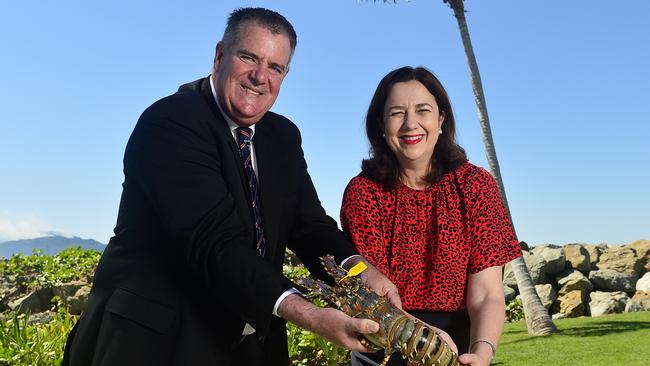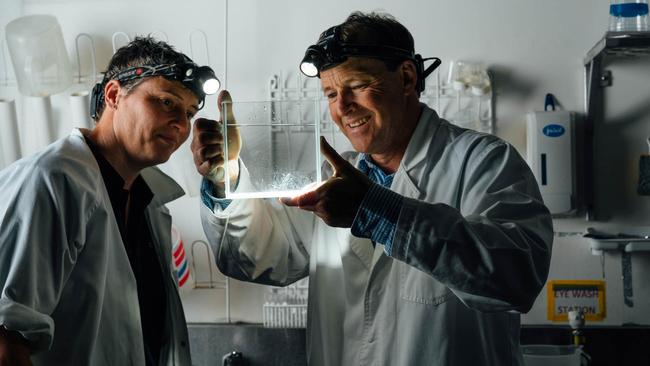WITHIN the next decade a restaurant in South-East Asia could be serving up a deliciously cooked rock lobster that grew up in an aquaculture facility at Toomulla Beach after being born in a tank in Tasmania.
There is about a 10,000-tonne shortfall of the popular shellfish globally due to a growing middle class throughout Asia, and Townsville is set to be the base that feeds that appetite.
The State Government last week announced Tasmania-based aquaculture company Ornatas had picked a site at Toomulla Beach to build the world’s first land-based lobster farm.
Ornatas chief executive Scott Parkinson said the plan was to spark a new $500 million industry and create 1000 jobs, not unlike the boom of the prawn farming industry that sprouted in the 1980s.
“We picked Townsville as the centre that we wanted to be close to,” he said.
“It’s a well-resourced centre, there’s a large population base, you’ve also got the likes of James Cook University, so you’ve already got an aquaculture program training people.”
HATCHING DISCOVERIES
Ornatas is a Tasmanian-owned company created about 18 months ago to monetise the cracking of the rock lobster breeding code, led by researchers at the University of Tasmania.
“With rock lobster research, it’s been 20 years in the making,” Associate Professor Greg Smith said.
“The work that we’ve done here at the University of Tasmania has been to complete the larval cycle in a commercial way. The larval cycle of the spiny rock lobster is long and difficult, in the wild it takes six to 12 months to complete.”

Scientists have now developed various techniques to shorten the life cycle and in a way that can produce tens of thousands of lobster babies.
This included creating artificial diets for larvae development, figuring out how to treat water so it resembles “high-quality” ocean, and how to mass rear larvae to the next stage of growth.
Previously, only a small amount of the animal could be grown by using unsustainable practices, Prof Smith said, including the use of antibiotics and catching juvenile lobsters from the wild.
The demand for juvenile lobsters has increased to about 10 million a year, depleting wild stocks.
“In the last ten years we’ve had a couple of large grants that has allowed us, with a large team of researchers, to focus on a number of aspects of the problem,” Prof Smith said.
“All around the world no one has been successful in cracking the code until we have here in the University of Tasmania.”
Once the troupe of scientists, which included experts in nutrition, genetics, physiology, larval biology, and engineers, found the secret sauce, they went to work attempting to do the same on the Moreton Bay bug.
Turns out they were much farther along than they thought.

CHRISTMAS BUGS
So that is where Ornatas will kick off its business. The Toomulla Beach site is expected to be ready by June 2020 and the first batch of farmed Moreton Bay bugs is set to hit the market by Christmas.
Meanwhile, the boffins in Tasmania will continue to work on perfecting the rock lobster process.
Ornatas is also building a $15 million tropical rock lobsters hatchery in Hobart that will be in production by 2021. “To do a grow-out you need to do it closer to where these guys are naturally, which is Queensland,” Mr Parkinson said.
By the time the first batch of Moreton Bay bugs leaves the facility, a total of 25 staff will be working on site with that number set to increase as production ramps up.
The Toomulla Beach facility will produce about 150 tonnes of Moreton Bay bugs over the next five years, before Ornatas begins working through the processes to ramp up into rock lobster production.

PICKING TOOMULLA
The site of Ornatas’ aquaculture facility, 40km north of Townsville just before the Toomulla Beach turn-off, has existed since 1985.
It was the second prawn farm to ever exist in Australia.
And the site wasn’t picked by chance.
University of Tasmania Associate Professor Greg Smith, one of the scientists who cracked the rock lobster aquaculture code, is a Townsville boy who worked as a technician at the Toomulla facility in 1986.
“I actually know the site pretty well,” he said. “It was called back then Aquaculture Industries, it was one of the first shrimp farms in Australia.”
The Endeavour Foundation owned the lease for all of that land, Prof Smith said, and there was an agreement back in the day that clients of the foundation would do work at the farm.
The site has changed hands a number of times.

Most recently it was owned by developer Rick Hobson under his company Prawns North Pty Ltd and he has since sold it to Ornatas for an undisclosed amount but believed to be in the millions. It is understood the site ceased producing prawns and barramundi about two to three years ago and has been disused ever since.
Ornatas took ownership of the site on September 2 and has already appointed a site manager.
Over the next 10 months, Mr Parkinson said, the company will invest more than $1.5 million to make the site operation ready.
“It’s what we call a brownfield site … the licences are in place the approvals are in place, but it hasn’t been operating for three years,” he said.
“We need to rehabilitate the site, we need to improve the quality of the ponds, all the infrastructure, and bring that back up to a condition that can be utilised.
“We’re working with a local firm, SMEC engineering, they’re working with us for a master plan for a 10-year strategy.”

INTO THE FUTURE
Mr Parkinson said the 1000 jobs comes from an industry developing around them based on the landmark science and development base they have built.
“You can see how the industry grows around us, and our Toomulla Beach site will be a demonstration for other companies to come in and work in this area,” he said.
“We will see that this technology will be transferred to other players in the industry and that we will supply them juvenile animals to grow out and also the technology around feed and systems for that to happen,” he said.
“Out of that there’s transportation, aqua feed production, all the additional resources from a scientific perspective.”
Ornatas plans on working with James Cook University to build science and engineering capabilities to support the company as it expands its operations in Queensland.
The plan is to train at least 100 new researchers, providing careers for marine science and aquaculture students.
Having already made a world first discovery in rock lobster science, Ornatas is confident it can launch a revolutionary industry from the ground up.
And as the Ornatas brochure states, they’re “set to achieve the once impossible”.


Add your comment to this story
To join the conversation, please log in. Don't have an account? Register
Join the conversation, you are commenting as Logout
Ex-Mad Cow manager in court for drug supply charge
When police clocked this man allegedly entering the toilet of a popular Flinders St pub, they grew suspicious. Here’s why.
‘Cruel, brutal’: 30 years on from confronting Rwanda mission
In the 1990s ADF personnel were called up to assist a country plagued by death and division. This year veterans will return to their old training grounds for the reunion.